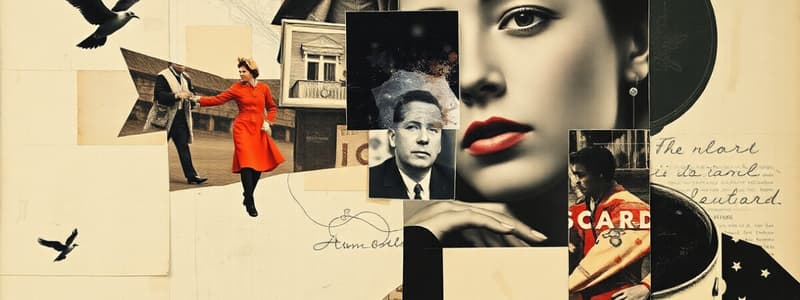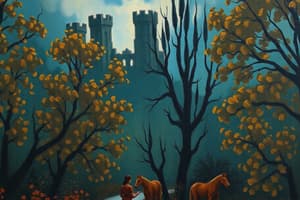Podcast
Questions and Answers
What are the three types of media codes?
What are the three types of media codes?
- Symbolic, Visual, Audio
- Cultural, Technical, Written
- Physical, Technical, Symbolic
- Symbolic, Technical, Written (correct)
Which element is NOT part of symbolic codes?
Which element is NOT part of symbolic codes?
- Mise en scene
- Setting
- Audio effects (correct)
- Acting
How does the setting influence a narrative?
How does the setting influence a narrative?
- It limits the character development.
- It creates atmosphere or builds a frame of mind. (correct)
- It provides a conclusion to the story.
- It dictates the dialogue of the characters.
What does the term 'mise en scene' refer to?
What does the term 'mise en scene' refer to?
What do media messages convey?
What do media messages convey?
How can acting contribute to a film's narrative?
How can acting contribute to a film's narrative?
What is the function of media language?
What is the function of media language?
Which of the following best describes symbolic codes?
Which of the following best describes symbolic codes?
What does the color red symbolize in media?
What does the color red symbolize in media?
Which of the following best describes technical codes in media?
Which of the following best describes technical codes in media?
What do story conventions in media refer to?
What do story conventions in media refer to?
How does lighting function in media production?
How does lighting function in media production?
What does genre convention refer to?
What does genre convention refer to?
What type of sound is included in audio as per media codes?
What type of sound is included in audio as per media codes?
What is the main role of written codes in media texts?
What is the main role of written codes in media texts?
What is a high-angle camera shot used for in photography?
What is a high-angle camera shot used for in photography?
Flashcards
Media Language
Media Language
The codes, conventions, formats, symbols, and narrative structure used in media to convey meaning to an audience.
Media Codes and Conventions
Media Codes and Conventions
The building blocks of media, consisting of agreed-upon elements that communicate meaning to viewers.
Messages in Media
Messages in Media
The information transmitted from a source to a receiver through media.
Symbolic Codes
Symbolic Codes
Signup and view all the flashcards
Technical Codes
Technical Codes
Signup and view all the flashcards
Written Codes
Written Codes
Signup and view all the flashcards
Setting (Media)
Setting (Media)
Signup and view all the flashcards
Mise-en-scène
Mise-en-scène
Signup and view all the flashcards
Acting (Media)
Acting (Media)
Signup and view all the flashcards
Color (Media)
Color (Media)
Signup and view all the flashcards
Media Codes
Media Codes
Signup and view all the flashcards
Technical Codes
Technical Codes
Signup and view all the flashcards
Color Codes
Color Codes
Signup and view all the flashcards
Lighting
Lighting
Signup and view all the flashcards
Audio
Audio
Signup and view all the flashcards
Written Codes
Written Codes
Signup and view all the flashcards
Conventions
Conventions
Signup and view all the flashcards
Form Conventions
Form Conventions
Signup and view all the flashcards
Story Conventions
Story Conventions
Signup and view all the flashcards
Genre Conventions
Genre Conventions
Signup and view all the flashcards
Camera Work
Camera Work
Signup and view all the flashcards
Study Notes
Codes, Conventions, and Language of Media
- Media codes and conventions are like building blocks
- They have generally agreed meanings for their audience
- Media language includes codes, conventions, format, symbols, narrative structure
- Messages are the information sent from one place to another.
Media Language
- Pertains to the symbolic and technical elements used to convey ideas
- Media professionals use these elements to communicate information and knowledge
- Codes and conventions are selected based on the objective
- Includes the way media language shows meaning to an audience
Codes
- Systems of signs that create meaning
- Three types: Symbolic, technical, written
Symbolic Codes
- Social in nature
- Exist outside media products
- Examples of these include setting, mise en scene, acting, & color
- Examples can be interpreted in everyday life
Setting
- Time and place of a narrative or scene
- Can be the whole story or just part of it
- Important in creating a particular mood
Mise en Scene
- French term meaning "everything within the frame"
- Includes analysis of costume, props, & objects
- Key to understanding a scene's message
Acting
- How an actor embodies a character
- Uses facial expression, body language, and vocal qualities
- Reflects character development and tension
Color
- Used to indicate connotations in media (Young, 2017)
- Red: Passion, danger, romance, violence
- Green: Nature or sickness
- Blue: Calm or depression
- Purple: Royalty
Technical Codes
- Ways equipment is used in media to tell a story (cameras, techniques, lighting)
- Includes camerawork, lighting
Camerawork
- How the camera is handled and moved (positioning)
- Specific shots create effects (high-angle shots create power)
Lighting
- Manipulation of natural or artificial light
- To highlight specific elements of the scene
Audio
- Expressive or naturalistic use of sound
- Includes dialogue, sound effects, and music
- Music often defines a scene
Written Codes
- Formal written language and style used
- Includes headlines, captions, and speech bubbles
Conventions
- Accepted ways of using media codes
- Three types: Form, story, genre conventions
Form Conventions
- Expected ways media codes are arranged
- In newspapers, important news is often at the front, sports news at the back, mastheads
Story Conventions
- Common narrative structures in media
- Include cause and effect, character construction, and point of view
Genre Conventions
- Common use of tropes, characters, settings, or themes in a particular medium
- Formal or thematic in nature
Studying That Suits You
Use AI to generate personalized quizzes and flashcards to suit your learning preferences.




